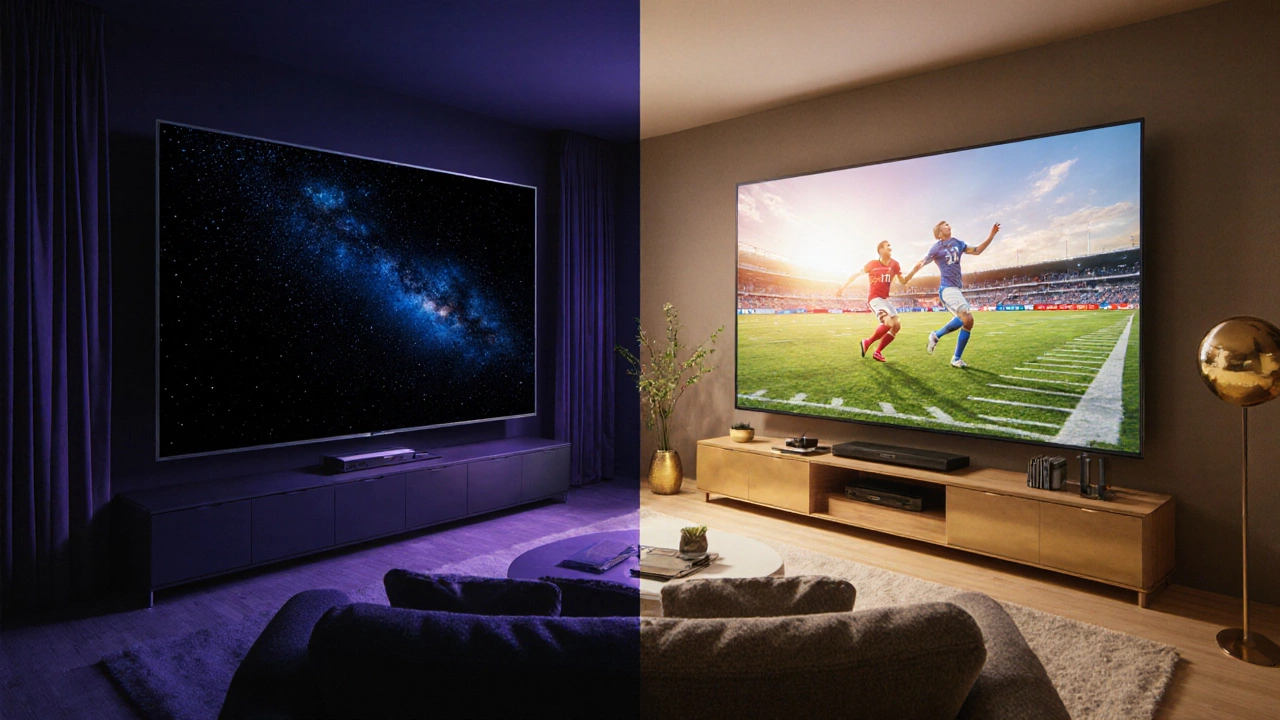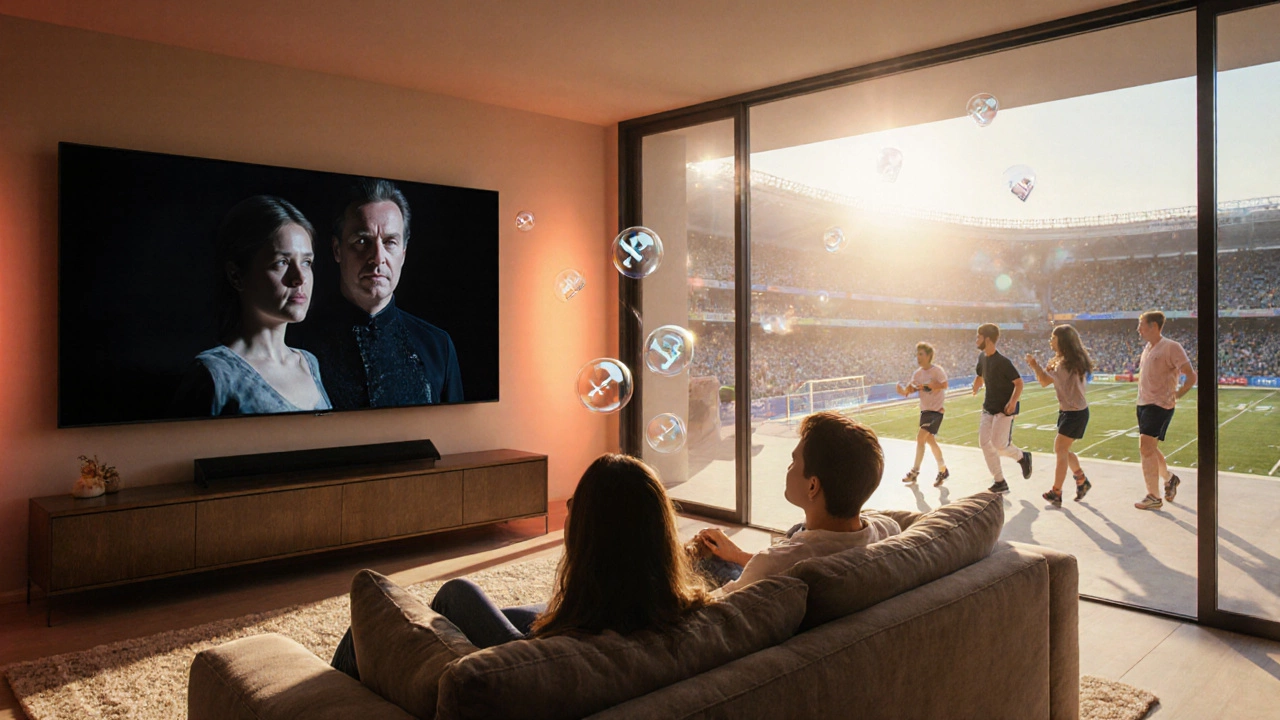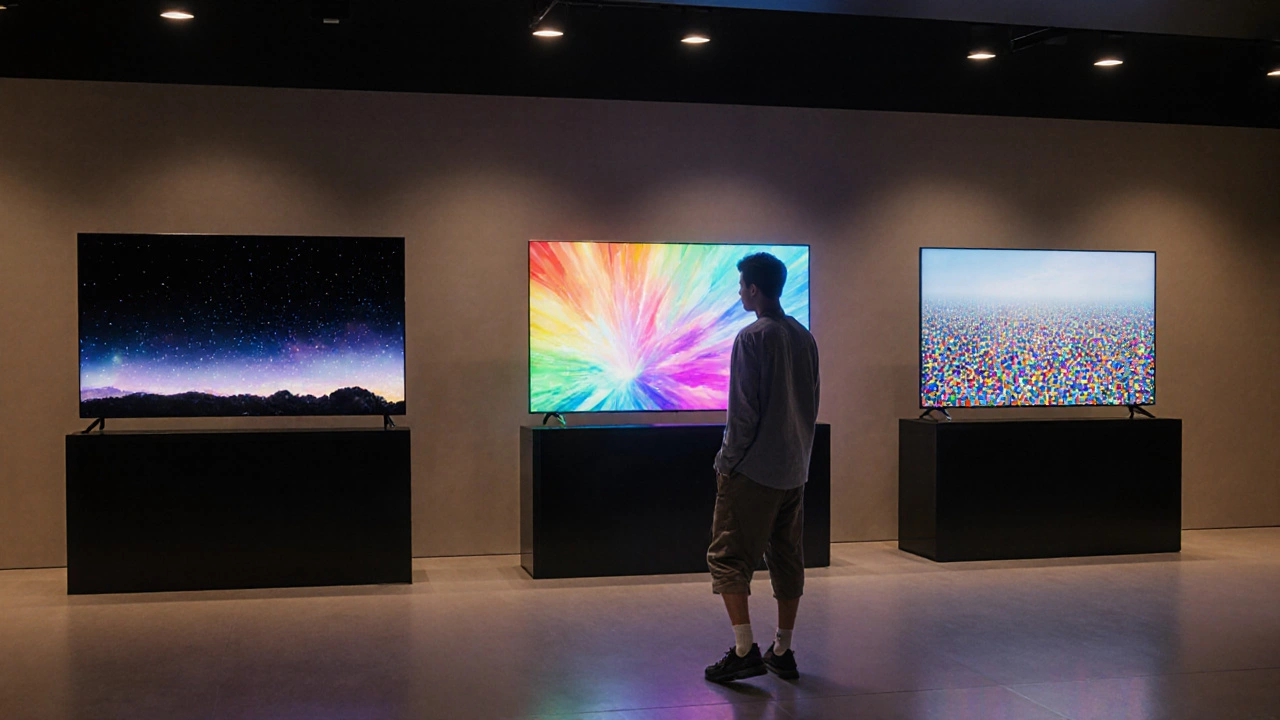TV Technology Selector
Find Your Perfect TV Technology
Why this recommendation?
Choosing a new TV feels like navigating a maze of specs and marketing buzz. You’ve probably seen the terms 4K, QLED, and OLED tossed around, but what do they actually mean for your living‑room experience? This guide cuts through the hype, compares the three technologies side‑by‑side, and tells you which one fits your budget, lighting conditions, and viewing habits.
Key Takeaways
- 4K is a resolution standard; it works with either QLED or OLED panels.
- OLED delivers the deepest blacks and most accurate colors, but can be pricey and may suffer burn‑in.
- QLED shines brightest in very lit rooms, offers high peak luminance, and generally costs less than OLED at similar sizes.
- Consider HDR support, HDMI 2.1 bandwidth, and refresh‑rate needs when matching a panel to your content sources.
- For most viewers in 2025, an OLED TV under $2,000 or a QLED model with Mini‑LED backlight are the best smart TV choices.
Understanding the Basics
4K is a display resolution of 3,840 × 2,160 pixels, offering four times the detail of classic 1080p HD. The higher pixel count sharpens text, textures, and when paired with a good upscaler, makes even older content look fresher. However, resolution alone does not dictate picture quality; the panel technology that drives those pixels matters just as much.
QLED stands for Quantum‑Dot Light Emitting Diode. Samsung popularized the term, but any TV using a quantum‑dot layer to boost color accuracy can be called QLED. The core of a QLED TV is still an LED‑backlit LCD panel, meaning it relies on a backlight that shines through a liquid‑crystal matrix.
OLED (Organic Light‑Emitting Diode) eliminates the backlight entirely. Each pixel emits its own light, turning completely off for true black and allowing infinite contrast ratios. OLED panels are usually made by LG Display, but manufacturers like Sony and Panasonic assemble them into finished TVs.
Performance Metrics That Matter
When you put a 4K QLED and a 4K OLED side by side, the differences you’ll notice fall into a few key categories.
- Brightness (nits): QLEDs often hit 1,500‑2,000 nits peak, making them ideal for bright rooms or daytime viewing. OLED tops out around 800‑1,000 nits, which is plenty for dim settings but can be washed out under direct sunlight.
- Contrast Ratio: OLED’s ability to power down individual pixels gives it a theoretical ∞:1 contrast, while QLED relies on local dimming zones and can achieve about 5,000‑10,000:1 in high‑end models.
- Color Gamut: Both technologies support the DCI‑P3 color space, but quantum‑dot filters in QLED push slightly higher saturation at peak brightness. OLED’s self‑emissive nature offers more natural skin tones at moderate brightness levels.
- HDR Compatibility: Look for HDR10+, Dolby Vision, and HLG support. Dolby Vision is more common on OLED (LG, Sony) while Samsung QLEDs favor HDR10+.
- Burn‑in Risk: OLED pixels can degrade if static logos sit on the screen for many hours. Modern OLEDs include pixel‑shift and logo‑dimming features, but the risk isn’t zero. QLED panels have no burn‑in concerns.
- Refresh Rate & HDMI 2.1: Gaming on a 4K TV benefits from 120 Hz panels and 48 Gbps HDMI 2.1 bandwidth. Both new QLED and OLED flagship models now include these specs; older OLEDs may be limited to 60 Hz.

Real‑World Viewing Scenarios
Dark Home Theater: If you have a dedicated viewing room with controlled lighting, OLED’s perfect blacks create a cinema‑like atmosphere. The subtle gradation in dark scenes (think Star Wars or Blade Runner) is far more immersive.
Bright Living Area: In an open‑plan space with windows, QLED’s higher peak brightness helps maintain punchy HDR highlights without glare. Mini‑LED backlights, now common in high‑end QLEDs, further improve local dimming.
Gaming: Both OLED and QLED models that support HDMI 2.1 and 120 Hz can handle next‑gen consoles. OLED’s near‑instant pixel response eliminates motion blur, while QLED’s higher brightness makes HDR gaming look vivid even in well‑lit rooms.
Sports: Rapid motion and vibrant colors favor a panel with high refresh rates and good motion handling. QLED’s strong brightness and anti‑reflective coatings keep outdoor stadium lighting from washing out the picture, while OLED’s deep blacks enhance night‑time scenes.
Price and Value
In 2025, OLED pricing has dropped significantly. A 55‑inch LG C3 OLED starts around $1,299, while the 65‑inch version sits near $1,899. QLED flagship models like the Samsung QN90B (Mini‑LED) start at $1,199 for 55‑inch and $1,599 for 65‑inch. Mid‑range QLEDs without Mini‑LED backlights can be found under $800, but they lack the same contrast performance.
If you’re on a tighter budget, a well‑reviewed 4K LED TV with HDR10 might suffice, but you’ll miss out on the premium contrast and color depth that define OLED and advanced QLEDs.
Future Trends: Mini‑LED, MicroLED, and Beyond
Manufacturers are blurring the lines between QLED and OLED. Mini‑LED backlighting adds thousands of dimming zones to an LCD panel, narrowing the contrast gap. Some brands label this as “QLED Mini‑LED” (e.g., Samsung’s “Neo QLED”).
MicroLED, still in early adopters’ hands, promises OLED‑level contrast with the durability of LED. Expect MicroLED to stay premium for at least another two years before reaching mainstream pricing.
For now, consider whether you need the absolute best picture or a balanced compromise. If you love a home theater vibe and can protect the screen from static logos, OLED wins. If you watch TV in a bright room and want longevity, QLED with Mini‑LED is the safer bet.

Buying Guide Checklist
- Confirm the TV supports at least HDR10 and Dolby Vision (or HDR10+ for QLED).
- Check for HDMI 2.1 ports-essential for 4K 120 Hz gaming and future‑proofing.
- Match screen size to viewing distance (multiply distance in inches by 0.5-0.6 for optimal immersion).
- Consider panel type:
- OLED for deepest blacks and cinema‑like contrast.
- QLED (especially Mini‑LED) for high brightness and bright‑room performance.
- Look for built‑in smart platforms (WebOS, Tizen, Google TV) that receive regular updates.
- Read recent reviews for the specific model year; manufacturers often tweak processing algorithms year‑over‑year.
Comparison Table
| Attribute | 4K (Resolution) | QLED (Mini‑LED) | OLED |
|---|---|---|---|
| Peak Brightness | - (depends on panel) | 1,500‑2,000 nits | 800‑1,000 nits |
| Contrast Ratio | - | 5,000‑10,000:1 (local dimming) | ∞:1 (pixel‑off) |
| Color Gamut | DCI‑P3 90‑95% | DCI‑P3 98‑100% | DCI‑P3 100% |
| HDR Formats | HDR10, HLG | HDR10+, HDR10, HLG | Dolby Vision, HDR10, HLG |
| Burn‑in Risk | None | None | Low‑moderate (mitigation required) |
| Typical Price (55") | $500‑$800 | $1,200‑$1,500 | $1,300‑$1,600 |
Frequently Asked Questions
Is 4K a type of TV technology?
No. 4K refers to pixel resolution (3840 × 2160). It can be paired with LED, QLED, OLED, or Mini‑LED panels.
Will OLED TVs suffer from burn‑in with regular use?
Modern OLEDs include pixel‑shift, logo dimming, and automatic screen savers that dramatically reduce the risk. For typical movie‑and‑gaming use, burn‑in is unlikely.
Can I use a QLED TV for HDR gaming?
Absolutely. Look for a QLED model with HDMI 2.1, 120 Hz refresh rate, and HDR10+ support to get the full benefit from PS5 or Xbox Series X.
Which TV offers the best value for a 65‑inch size?
In 2025, the Samsung QN90B (Neo QLED Mini‑LED) and the LG C3 OLED are neck‑and‑neck. The QN90B usually edges out on price and brightness, while the C3 wins on contrast and color depth.
Do I need a TV with HDMI 2.1 if I only watch streaming services?
Streaming services like Netflix and Disney+ currently max out at 4K 60 Hz. HDMI 2.0 is sufficient, but HDMI 2.1 future‑proofs the TV for gaming and next‑gen consoles.
Whether you gravitate toward the cinematic darkness of OLED or the bright‑room punch of QLED, knowing the strengths and trade‑offs lets you pick a TV that truly fits your space and viewing habits. Armed with this comparison, you can shop confidently and enjoy the picture quality you deserve.

